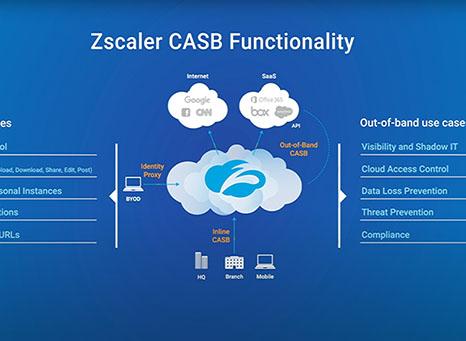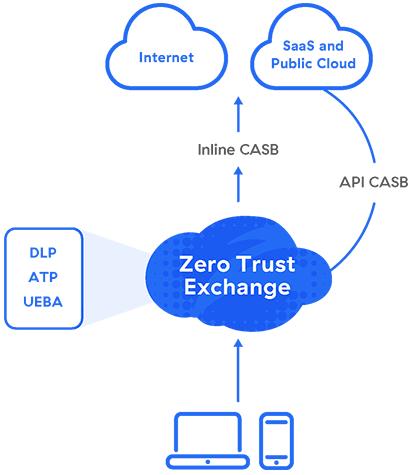/ What Is a Cloud Access Security Broker (CASB)?
What Is a Cloud Access Security Broker (CASB)?
A cloud access security broker (CASB) is an enforcement point that sits between cloud application users and cloud services to provide data protection and threat protection services. CASBs automatically prevent sensitive data leakage, stop malware and other threats, discover and control shadow IT, block risky sharing, enforce security policies such as authentication and alerting, and ensure compliance.

Why Is a CASB Needed Today?
With increased cloud adoption, CASBs have become a key element of enterprise security for their various cybersecurity, access control, and data protection functions. They give you back control over corporate data, in motion or at rest, in cloud platforms and apps. CASBs are critical because:
- The growth of cloud platforms and apps (e.g., Microsoft 365, Salesforce) has made traditional network security tools, such as data center firewalls, far less effective.
- IT teams don’t have the control they once had. Almost anyone can pick up and use a new cloud app, and IT can’t manually manage granular user access controls at that scale.
- They can apply policy to provide shadow IT control, cloud data loss prevention (DLP), SaaS security posture management (SSPM), and advanced threat protection.
The Role of CASBs for Businesses
As guardians of activity in and around cloud environments—offering visibility into activity, security policy enforcement, threat detection, and data protection—CASBs enable businesses to confidently embrace the cloud while maintaining control and ensuring regulatory compliance. Let’s take a closer look at some of the concrete benefits of a CASB.
Benefits of CASB
An effective CASB solution offers key benefits as part of a holistic cloud security strategy:
Visibility into Shadow IT and Risk
Amid the rise of remote work and BYOD, organizations need clear visibility into the users, devices, and SaaS applications accessing their cloud environments. With it, the risk of unauthorized access skyrockets. A CASB discovers your organization’s cloud app usage, reports on cloud spend, and assesses risk to help you create and maintain appropriate access policies.
Cloud Usage Management
Use of the cloud can be subject to an array of compliance mandates, especially in highly regulated industries like financial services, healthcare, and the public sector. A CASB can identify the greatest risk factors in your industry and set stringent data protection policies to help you achieve and maintain compliance across your organization.
Data Security and DLP
The volume of the world’s data doubles in size every two years, and data risk grows in kind. Combining a CASB with cloud DLP lets you see both see and remediate potential risks. With visibility into sensitive content traveling to, from, or between cloud environments, you have the best chance to identify incidents, enforce policy, and keep data secure.
Threat Prevention
In today’s IT ecosystem, cloud resources are usually the most vulnerable. With the behavior analytics and threat intelligence of an effective CASB, you can quickly identify and remediate suspicious activity, keep cloud applications and data secure, and bolster your organization’s overall cloud security posture.
How to Implement a CASB
At the highest level, implementing a CASB is a matter of assessing your needs, matching them to the right product, setting it up in the way that best suits your systems, and performing ongoing monitoring and audits. You could look at it in five steps:
- Assess your environment and make a plan. Understand the cloud services and apps in use, attendant risks, and your security policy and compliance needs.
- Select the right CASB solution for your needs. Just as important as finding the right product, find the right vendor—choose a partner you know you can trust.
- Integrate the CASB with your cloud services and user directories. Use SSO to enable secure user access and seamless authentication.
- Configure access, data sharing, DLP, and security policies. Depending on your industry, you may need to take special care with your policies around encryption.
- Enable real-time monitoring and threat detection. You’ll also need to regularly review and update your policies as your organization’s needs evolve.
How Do CASBs Work?
CASB solutions can take the form of on-premises hardware or software, but they’re best delivered as a cloud service for greater scalability, lower costs, and easier management. Whatever the form factor, CASBs can be set up to use proxying (forward proxy or reverse proxy), APIs, or both—a multimode CASB.
Proxy
CASBs need to operate in the data path, so the ideal CASB is founded on a cloud proxy architecture. Forward proxies are more often used with CASB, ensuring users’ privacy and security from the client side.
A forward proxy intercepts requests for cloud services en route to their destination. Then, based on your policy, the CASB enforces credential mapping and single sign-on (SSO), device posture profiling, logging, alerting, malware detection, encryption, and tokenization.
API
While an inline proxy intercepts data in motion, you need out-of-band security for data at rest in the cloud, which CASB vendors provide through integrations with cloud service providers’ application programming interfaces (APIs).
What’s a Multimode CASB?
In proxy mode, CASBs provide inline policy enforcement that stops leakage and malware in real time. They can also integrate with APIs to scan SaaS apps’ contents, enabling them to find and respond to sensitive data patterns as well as threats such as ransomware. More recently, API integrations have been used for SaaS security posture management (SSPM), by which CASBs remediate misconfigurations in applications.
CASBs that offer both proxy and API-based modes are called multimode CASBs. Beyond securing SaaS, they can protect IaaS such as Microsoft Azure and AWS S3. And rather than deploying a CASB as another point product, you can deploy it as part of an SSE platform to ensure consistent security, enhanced performance, and consolidated administration.
What Does Gartner Say About CASB?
Gartner first defined “CASB” in 2012, when organizations primarily used the technology to control shadow IT.
CASB benefits and capabilities began to overlap more with secure web gateways (SWG), and in 2019, Gartner defined the secure access service edge (SASE), a framework of cloud-delivered services that provide “comprehensive WAN capabilities with comprehensive network security functions (such as SWG, CASB, FWaaS, and ZTNA) to support the dynamic secure access needs of digital enterprises.”
In 2021, Gartner distilled this further, identifying the security-centric slice of SASE as the security service edge (SSE). This reflects growing efforts worldwide to streamline complex, disjointed security stacks, with Gartner predicting that 30% of enterprises will have adopted SWG, CASB, ZTNA, and firewall as a service (FWaaS) capabilities from the same vendor by 2024.
CASB and SASE
CASB and SASE complement one another, with CASB securing cloud interactions and data flows while SASE more broadly integrates cloud security, networking, and access control. SASE includes CASB by definition, enabling organizations to enforce policies and secure data as part of their network architecture.
Zscaler is a Leader in the 2023 Gartner Magic Quadrant for Security Service Edge (SSE).
Top Use Cases for CASB
1. Discover and Control Shadow IT
When your users store and share corporate files and data in unsanctioned cloud apps, your data security suffers. To counteract this, you need to understand and secure cloud usage in your organization.
Zscaler CASB automatically discovers shadow IT, revealing the risky apps visited by users. Automated, easily configurable policies then enforce various actions (e.g., allow or block, prevent upload, restrict usage) on individual apps and app categories.
2. Secure Non-Corporate SaaS Tenants
Users may use both sanctioned and unsanctioned instances of apps like Google Drive. Responding by either allowing or blocking the app entirely can encourage inappropriate sharing or hamper productivity, respectively.
Zscaler CASB can distinguish between sanctioned SaaS tenants and unsanctioned instances, applying appropriate policy enforcement to each. Preconfigured SaaS tenancy controls deliver automated, real-time remediation.
3. Control Risky File Sharing
Cloud apps enable unprecedented sharing and collaboration. As a result, your security teams need to know who’s sharing what in sanctioned apps, lest you risk letting dangerous parties get hold of your data.
Collaboration management is a key capability of any effective CASB. Zscaler CASB quickly and repeatedly crawls files in your SaaS tenants to identify sensitive data, check the users with whom files are shared, and automatically respond to risky shares as needed.
4. Remediate SaaS Misconfigurations
When deploying and managing a cloud application, precise configuration is key to ensure the app functions properly and securely. Misconfigurations harm your security hygiene and can easily expose sensitive data.
Zscaler SSPM integrates with your SaaS tenants via API to scan for misconfigurations that could jeopardize regulatory compliance. It’s one component of Zscaler Workload Posture alongside CSPM and CIEM.
5. Prevent Data Leakage
In addition to cloud resource misconfigurations that could enable data breaches and leaks, you need to identify and control sensitive data patterns in the cloud. A vast amount of such data is regulated under frameworks like HIPAA, PCI DSS, GDPR, and many others.
The Zero Trust Exchange, our cloud native security platform, provides unified data protection with cloud DLP and CASB capabilities. It ensures cloud apps are properly configured to stop data loss and noncompliance, backed up with advanced data classification techniques to identify and secure sensitive data wherever it goes.
6. Prevent Successful Attacks
Once an infected file gets past your organization’s security into one of your sanctioned cloud apps, it can quickly spread to connected apps and other users’ devices. That’s why you need a way to defend against threats in real time both at upload and at rest.
Zscaler CASB thwarts malware’s advances with advanced threat protection (ATP) capabilities, including:
- Real-time proxy to prevent malicious files from being uploaded to the cloud
- Out-of-band scanning to identify files at rest and remediate threats
- Cloud sandboxing to identify even zero-day malware
- Agentless Cloud Browser Isolation to secure access from unmanaged endpoints
Zscaler CASB
Zscaler delivers multimode CASB as a service along with SWG, ZTNA, and more as part of our comprehensive Zscaler Zero Trust Exchange™ platform to help you eliminate point products, reduce IT complexity, and inspect traffic in a single pass. Your administrators simply configure one automated policy for consistent security across all cloud data channels.
Inline Security for Cloud Data in Motion
High-performance forward proxy and SSL inspection provide critical real-time protection:
- Shadow IT discovery and cloud app control identify and secure unsanctioned apps without requiring network device logs
- DLP measures prevent uploads of sensitive data to sanctioned and unsanctioned apps
- Advanced threat protection stops known and unknown malware in real time with machine learning-powered cloud sandboxing
- Cloud Browser Isolation streams sessions as pixels for BYOD to prevent data leakage without a reverse proxy
Out-of-Band Security for Data at Rest
API-based scanning of SaaS apps, cloud platforms, and their contents automatically enhances your security:
- Predefined and customizable DLP dictionaries identify sensitive data in SaaS and public clouds
- Collaboration management functionality crawls apps for risky file shares and revokes them according to policy
- Cloud sandboxing scans data at rest to identify and respond to zero-day malware and ransomware
- SSPM, CSPM, and CIEM evaluate SaaS and IaaS configurations and permissions to remediate issues automatically

Achieve SaaS security with Zscaler CASB.
Suggested Resources
Frequently Asked Questions
Any organization with important data and apps stored in cloud services should use a CASB. It monitors and controls data sent between your network and the cloud to ensure compliance, prevent leaks, and stop unauthorized access. CASBs help maintain visibility and control over sensitive data as well as address many inherent security risks of the cloud.
A CASB acts as a checkpoint between your network and cloud services, monitoring and managing data traffic to and from cloud apps, providing visibility into user activities, enforcing security policies, detecting threats, and protecting sensitive data. CASBs help maintain control, compliance, and data protection for your network cloud environment.
To find the right CASB for your enterprise, start by evaluating what you need to protect, at what scale, and which cloud services you use. The right CASB will offer robust threat detection, granular access controls, strong encryption, and integration with your existing security infrastructure and cloud environment. Finally, you’ll want to find the right technology partner—one you can trust to work with you to make your chosen CASB solution the best fit for your needs.
Many CASBs incorporate DLP features to prevent sensitive data from moving from your network to the cloud (or the reverse) without authorization. DLP functions monitor data traffic, block or encrypt sensitive data, and send alerts on potential breaches or leaks. Together, CASB and DLP help control the movement of data and protect sensitive information traveling between on-premises networks and cloud services.
A CASB is an essential piece of strong cloud security, but it doesn't stand alone. Effective cloud security combines CASB with robust identity and access management, encryption, network security, regular security auditing, and more. CASB focuses on securing data flows between an organization's network and the cloud, but comprehensive cloud security covers broader range of potential threats across all aspects of cloud infrastructure and usage.



